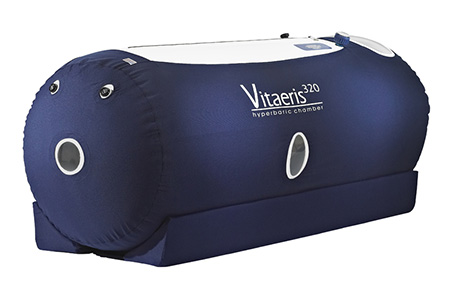Hyperbaric Oxygen Therapy
In-Home Rentals

About Hyperbaric Therapy
The medical basis of HBOT is based on the laws of physics. “Henry’s Law,” says that the amount of a gas dissolved in a liquid is in proportion to the pressure of the gas above the liquid, provided that no chemical action occurs. “Boyle’s Law” states that at a constant temperature, the volume and the pressure of a gas are inversely proportional. In other words, gas will compress proportionately to the amount of pressure exerted on it. An example of these laws would be found in a sealed bottle of carbonated beverage. Until the bottle has been opened, the gas bubbles are dissolved in the fluid. Once the bottle has been opened, the pressure is released, and the gas is no longer dissolved in the liquid (as seen by the formation of bubbles).
At room pressure, almost all oxygen that we breathe is transported in the red blood cells. When a patient is treated with Hyperbaric Oxygen Therapy, the oxygen can dissolve in the patient’s serum (the part of the bloodstream that is fluid, not blood cells). The result of using HBOT is that more life-sustaining oxygen is delivered to the tissues and organs. Also, due to the effects of HBOT, blood vessels are opened up, so more blood flows to these areas. This can bring more nutrients to the cells, and theoretically may facilitate greater removal of toxins that accumulate in the organs.
The FDA has approved HBOT for the following medical conditions:
- Air or Gas Embolism
- Carbon Monoxide Poisoning and Smoke Inhalation
- Carbon Monoxide Poisoning Complicated by Cyanide Poisoning
- Clostridial Myonecrosis (Gas Gangrene)
- Crush Injury
- Compartment Syndrome and other Acute Traumatic Ischemias
- Decompression Sickness (the “Bends”)
- Enhancement of Healing in Selected Problem Wounds Exceptional Blood Loss (Anemia)
- Necrotizing Soft Tissue Infections
- Osteomyelitis (Refractory)
- Radiation Tissue Damage (Osteoradionecrosis)
- Skin Grafts and Flaps (Compromised)
- Thermal Burns.
Medical Research has also shown HBOT may be helpful for treating other conditions, including (but are not limited to):
- Athletic Injuries
- Autism
- Autoimmune Diseases
- Chemotherapy/Radiation Recovery
- Skin Conditions
- Hyperinflammatory Conditions
- Rheumatic Diseases
The FDA has not evaluated the use of HBOT for these conditions.
